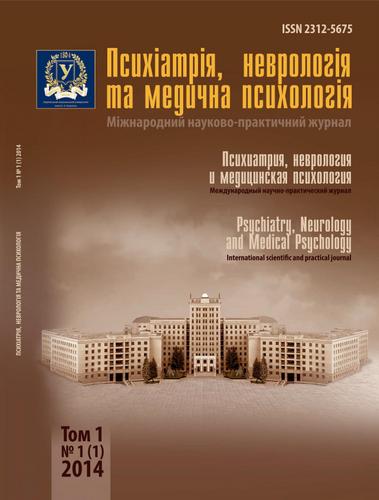Features of Social Dysfunction In Students with Congenital Heart Disease, And Principles of Psychocorrection
Abstract
Persons with CHD are characterized by basic social dysfunction: high levels of reactive anxiety, neurotic and emotionally labile profi les, unstable motivation to success, the presence of destructive psychological defense mechanisms in the presence of stress, such as “Suppression”, “Compensation” and “Rationalization”; interpsychic orientation relationship to disease (“Sensitivity” and “Self-centered”); reduced physical component of quality of life, namely indicators of physical functioning general health. Students with SVD CSS disorders obtain a high level of reactive anxiety and trait anxiety, and depressive symptoms; profi les of spontaneous aggression, depression, irritability and poor balance, stability of the low motivation to succeed, the presence of destructive mechanisms to protect the type of “regression”, “Replacement” and “Denial”; observed intrapsychic orientation relationship to disease (“Anxiety”, “hypochondriac” and “neurotic”); reduced mental health component (mental health (, role functioning due to emotional state, vital activity and the physical component of quality of life (physical functioning and role functioning due to physical condition. The fi ndings of the factor analysis were formed by two types of social dysfunction in patients with CHD and one common ont for individuals with SVD CVS, “Reactive-the sensitive” type of social dysfunction in individuals with “white” heart defects, “Reactive-self-centered” type of NSF in patients with “blue” heart defects, “Rigid-fi xation” in patients with SVD CVS.
Downloads
References
Prince M. No health without mental health [Text] / M. Prince, V. Patel, S. Saxena et al. // Lancet. – 2007. – Vol. 370. – P. 859 – 877.
Birkenhager W. H. Psychosomatic sequelae of hypertension labelling [Text] / W. H. Birkenhager // J. Hypertens. – 2003. – Vol. 21, No 7. – P. 1235 – 1236.
Ware J. Overview of the SF-36 Health Surveg and the International anality of Life Assessment (JQOLA)/ J. Ware, B. Gandek // Projekt J. Clin. Epidemiology. – 2011. – Vol. 11. – P. 903 – 912.
Сенаторови А. С. Современное состояние вопроса диагностики и лечения детей раннего возраста с сердечной недостаточностью [Текст] / А. С. Сенаторови, И. М. Галдина / // Современная педиатрия. – 2012. – No 2. – С. 41 – 46.
Ebrahim S. Fixed-dose combination therapy for the prevention of cardiovascular disease [Text] / Ebrahim S. / A. N. de Cates; M. R. Farr; N. Wright; M. C. Jarvis; K. Rees; S. Ebrahim; M. D. Huff man // Cochrane Database Syst Rev. – 2014. – Р. CD009868
Марута Н. О. Клініко психопатологічні і патопсихологічні закономірності формування дистонії [Текст] / Н. О. Марута, Ю. М. Завалко // Укр. вісн. психоневрології. – 2008. – Т. 16, вип. 1(54). – С. 23 – 25.
Шевченко Н. Ф. Розвиток емоційно-вольової са-морегуляції студентів в умовах вищого навчального закладу станів [Текст] / Н. Ф. Шевченко // Педагогічні науки: теорія історія, інноваційні технології. – Суми: СумДПУ ім. А. С. Макаренка. – 2010. – No 3(1). – С. 270–280.
Маркова М. В. До питання впливу непсихотичних психічних розладів, коморбідних з хворобами системи кровообігу, на їх перебіг (на моделі артеріальної гіпер-тензії та невротичних розладів) [Текст] / М. В. Маркова, Є. М. Харченко, Н. М. Степанова [та ін.] // Укр. вісн. пси-хоневрології. – 2007. – Т. 5, вип. 1. – С. 205.
Висковатова Т. П. Психология успешности личности в бизнесе: [монография] / Т. П. Висковатова, Т. П. Чернявская. – Одесса: Астропринт, 2010. – 286 с.
Mykhaylov B. Contemporary psychotherapeutic carein Ukraine [Text] / B. Mykhaylov // PostersP-1160.Thejournalof the European Psychiatric Association. 20thEuropean Congressof Psychiatry. 3-6 March. 2012. Prague.Czech Republik).
Anger expression, violent behavior, and symptoms of depression among male college students / Dale J. Terasaki, Bizu S Gelaye, Yemane Berhane [et. al.] // BMC Public Health.– 2009.– 9:13.– P. 1–25.
Copyright (c) 2014 T. A. Aliieva

This work is licensed under a Creative Commons Attribution 4.0 International License.

